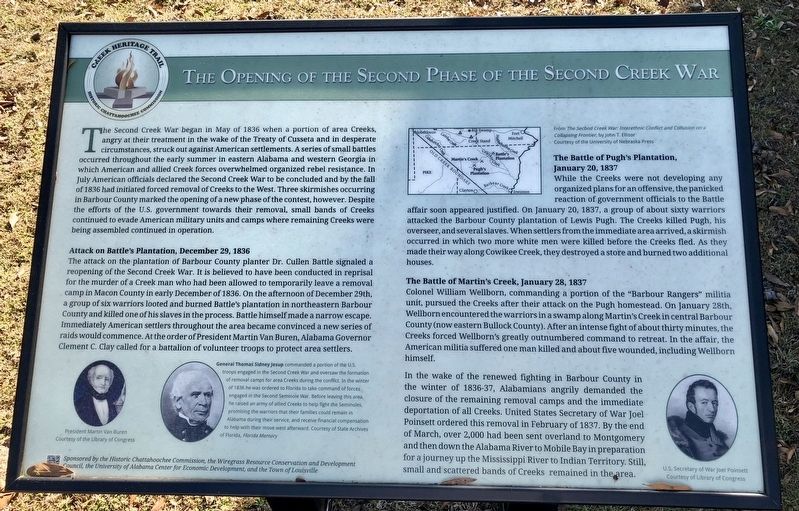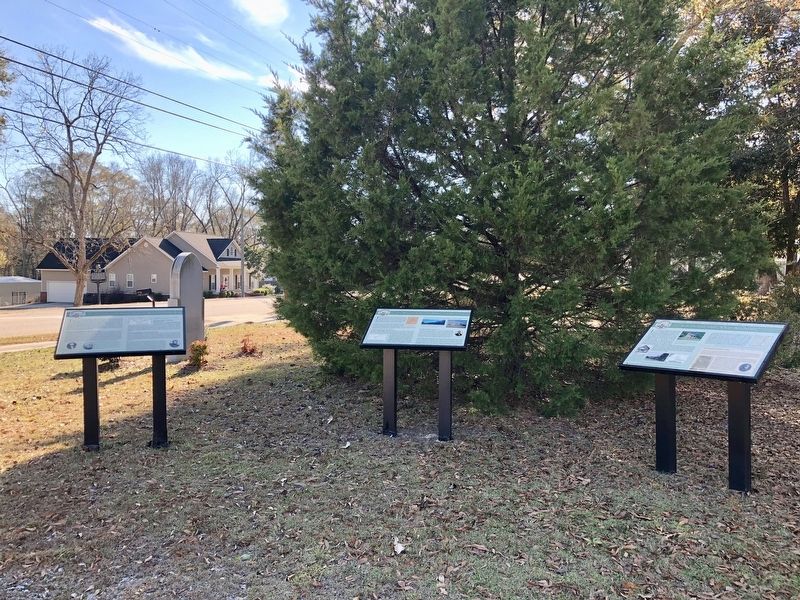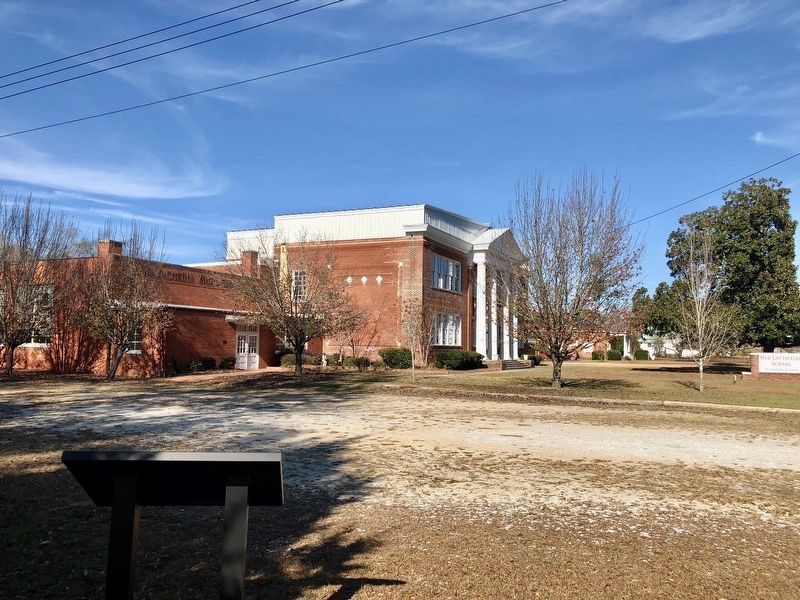Louisville in Barbour County, Alabama — The American South (East South Central)
The Opening of the Second Phase of the Second Creek War
— Creek Heritage Trail —
Inscription.
The Second Creek War began in May of 1836 when a portion of area Creeks, angry at their treatment in the wake of the Treaty of Cusseta and in desperate circumstances, struck out against American settlements. A series of small battles occurred throughout the early summer in eastern Alabama and western Georgia in which American and allied Creek forces overwhelmed organized rebel resistance. In July American officials declared the Second Creek War to be concluded and by the fall of 1836 had initiated forced removal of Creeks to the West. Three skirmishes occurring in Barbour County marked the opening of a new phase of the contest, however. Despite the efforts of the U.S. government towards their removal, small bands of Creeks continued to evade American military units and camps where remaining Creeks were being assembled continued in operation.
Attack on Battle's Plantation, December 29, 1836
The attack on the plantation of Barbour County planter Dr. Cullen Battle signaled a reopening of the Second Creek War. It is believed to have been conducted in reprisal for the murder of a Creek man who had been allowed to temporarily leave a removal camp in Macon County in early December of 1836. On the afternoon of December 29th, a group of six warriors looted and burned Battle's plantation in northeastern Barbour County and killed one of his slaves in the process. Battle himself made a narrow escape. Immediately American settlers throughout the area became convinced a new series of raids would commence. At the order of President Martin Van Buren, Alabama Governor Clement C. Clay called for a battalion of volunteer troops to protect area settlers.
The Battle of Pugh's Plantation,
January 20, 1837
While the Creeks were not developing any organized plans for an offensive, the panicked reaction of government officials to the Battle affair soon appeared justified. On January 20, 1837, a group of about sixty warriors attacked the Barbour County plantation of Lewis Pugh. The Creeks killed Pugh, his overseer, and several slaves. When settlers from the immediate area arrived, a skirmish occurred in which two more white men were killed before the Creeks fled. As they made their way along Cowikee Creek, they destroyed a store and burned two additional houses.
The Battle of Martin's Creek, January 28, 1837
Colonel William Wellborn, commanding a portion of the "Barbour Rangers" militia unit, pursued the Creeks after their attack on the Pugh homestead. On January 28th, Wellborn encountered the warriors in a swamp along Martin's Creek in central Barbour County (now eastern Bullock County). After an intense fight of about thirty minutes, the Creeks forced Wellborn's
greatly outnumbered command to retreat. In the affair, the American militia suffered one man killed and about five wounded, including Wellborn himself.
In the wake of the renewed fighting in Barbour County in the winter of 1836-37, Alabamians angrily demanded the closure of the remaining removal camps and the immediate deportation of all Creeks. United States Secretary of War Joel Poinsett ordered this removal in February of 1837. By the end of March, over 2,000 had been sent overland to Montgomery and then down the Alabama River to Mobile Bay in preparation for a journey up the Mississippi River to Indian Territory. Still, small and scattered bands of Creeks remained in the area.
Photo captions:
Bottom left: Martin Van Buren
General Thomas Sidney Jesup commanded a portion of the U.S. troops engaged in the Second Creek War and oversaw the formation of removal camps for area Creeks during the conflict. In the winter of 1836 he was ordered to Florida to take command of forces engaged in the Second Seminole War. Before leaving this area, he raised an army of allied Creeks to help fight the Seminoles, promising the warriors that their families could remain in Alabama during their service, and receive financial compensation to help with their move west afterward.
Top right map: From the Second Creek War: Interethnic Conflict and Collusion on a Collapsing Frontier
Bottom right: U.S. Secretary of War Joel Poinsett
Erected 2015 by the Historic Chattahoochee Commission, the Wiregrass Resource Conservation and Development Council, the University of Alabama Center for Economic Development, and the Town of Louisville.
Topics and series. This historical marker is listed in these topic lists: Native Americans • Wars, US Indian. In addition, it is included in the Former U.S. Presidents: #08 Martin Van Buren series list. A significant historical date for this entry is January 20, 1837.
Location. 31° 47.304′ N, 85° 33.159′ W. Marker is in Louisville, Alabama, in Barbour County. Marker is on North Main Street (Alabama Route 51) 0.6 miles south of West Street, on the right when traveling south. Located on the grounds of the Old Louisville School. Touch for map. Marker is at or near this postal address: 1871 North Main Street, Louisville AL 36048, United States of America. Touch for directions.
Other nearby markers. At least 8 other markers are within 5 miles of this marker, measured as the crow flies. The Battles of Hobdy's Bridge and Pea River (here, next to this marker); Louisville (here, next to this marker); Louisville and "Old Alabama" (here, next to this marker); The Old County Court House (within shouting distance of this marker); Fire Bell (approx. 0.4 miles away); Louisville World War II Memorial (approx. ¾ mile away); Barbour County's "Little Scotland"/Pea River Presbyterian Church (approx. 4.6 miles away); Pea River Presbyterian Church Cemetery (approx. 4.6 miles away). Touch for a list and map of all markers in Louisville.
Credits. This page was last revised on December 17, 2017. It was originally submitted on December 17, 2017, by Mark Hilton of Montgomery, Alabama. This page has been viewed 588 times since then and 48 times this year. Photos: 1, 2, 3. submitted on December 17, 2017, by Mark Hilton of Montgomery, Alabama.


